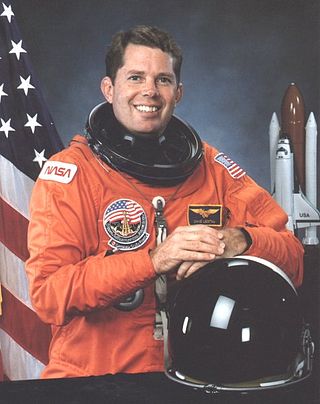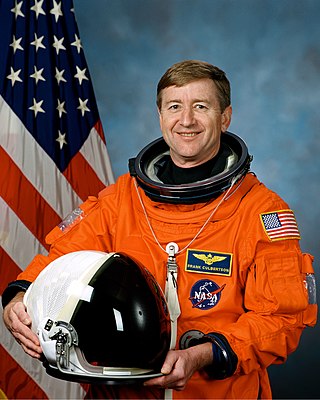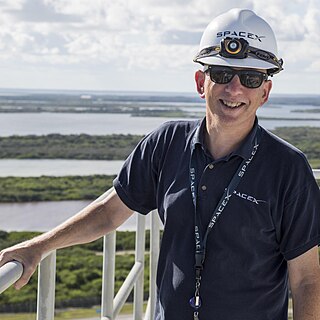
John Howard Casper is a former American astronaut and retired United States Air Force pilot.

David Cornell Leestma is a former American astronaut and retired Captain in the United States Navy.

Frank Lee Culbertson Jr. is an American former naval officer and aviator, test pilot, aerospace engineer, NASA astronaut, graduate of the US Naval Academy, and member of the United States Astronaut Hall of Fame. He served as the commander of the International Space Station for almost four months in 2001 and was the only U.S. citizen not on Earth when the September 11 attacks occurred.

George David Low was an American aerospace executive and a NASA astronaut. With undergraduate degrees in physics and mechanical engineering and a master's degree in aeronautics and astronautics, he worked in the Jet Propulsion Laboratory (JPL) at the California Institute of Technology in the early 80's, before being picked as an astronaut candidate by NASA in 1984. In addition to holding some technical assignments, he logged more than 700 hours in space, before he left NASA in 1996 to pursue a career in the private sector. He was the son of George M. Low, the manager of the Apollo Spacecraft Program Office, and later, the 14th president of Rensselaer Polytechnic Institute.

Michael James "Mike" McCulley, , is a retired American naval officer and aviator, test pilot, metallurgical engineer, and former NASA astronaut, and was the first submariner in space. He served as pilot on STS-34 Atlantis mission that among other things deployed the Galileo spacecraft on its journey toward Jupiter.

Richard Alan Searfoss was an American aviator who was United States Air Force colonel, NASA astronaut and test pilot.

Daniel M. Tani is an American engineer and retired NASA astronaut. He was born in Ridley Park, Pennsylvania, but considers Lombard, Illinois, to be his hometown.

James Shelton Voss is a retired United States Army colonel and NASA astronaut. During his time with NASA, Voss flew in space five times on board the Space Shuttle and International Space Station. He also served as deputy of Flight Operations for the Space Station Program Mission Integration and Operations Office. While participating in ISS Expedition 2, he and Susan Helms conducted an 8-hour and 56 minute spacewalk, the longest to date.

Carl Erwin Walz is a retired NASA astronaut currently working for Orbital Sciences Corporation's Advanced Programs Group as vice president for Human Space Flight Operations. Walz was formerly assigned to the Exploration Systems Mission Directorate at NASA Headquarters in Washington, D.C. He was the Acting Director for the Advanced Capabilities Division in the Exploration Systems Mission Directorate, and was responsible for a broad range of activities to include Human Research, Technology Development, Nuclear Power and Propulsion and the Lunar Robotic Exploration Programs to support the Vision for Space Exploration.

John F. Muratore is a former NASA systems engineer-project manager and launch director at SpaceX. He is well known in the aerospace circles for his gregarious and unconventional style and use of rapid spiral development to reduce cost and schedule for introducing technical innovations.

George William Samuel Abbey is a former director of the Johnson Space Center (JSC) and Fellow in Space Policy at the Baker Institute of Rice University.

Gerald D. Griffin is an American aeronautical engineer and former NASA official, who served as a flight director during the Apollo program and director of Johnson Space Center, succeeding Chris Kraft in 1982.

William H. Gerstenmaier is an aerospace engineer and policymaker who is Vice President, Build and Flight Reliability at SpaceX. He previously served as NASA's Associate Administrator for Human Exploration and Operations between 2005 and July 10, 2019. While in that role, he was described as "arguably the most influential person when it comes to US spaceflight." Prior to being Associate Administrator, Gerstenmaier served as the International Space Station Office Program Manager, at Johnson Space Center, a position he began in June 2002. He spent a total of four decades with NASA.

Lee R. Scherer was an American aeronautical engineer and director of NASA's John F. Kennedy Space Center (KSC) from January 19, 1975 to September 2, 1979. Prior to his appointment as KSC director, Scherer was director of NASA's Flight Research Center, Edwards, California, responsible for the conduct of advanced aeronautical flight research.

Walter Charles Williams was an American engineer, leader of the National Advisory Committee for Aeronautics (NACA) group at Edwards Air Force Base in the 1940s and 1950s, and a NASA deputy associate administrator during Project Mercury.

Kenneth Stanley Reightler Jr. is a former NASA astronaut.

Robert E. "Rob" Meyerson is an American aerospace engineer and executive known for his role in the development of reusable rocket launch systems.

Kathryn (Kathy) Lueders is an American engineer and business manager. Lueders has led NASA's human spaceflight program as the Associate Administrator of the Human Exploration and Operations (HEO) Mission Directorate. She became the first woman to head human spaceflight. She was the program manager for NASA's Commercial Crew Program and oversaw the return of human spaceflight capabilities to NASA. She currently works at SpaceX.

Beth Moses is Chief Space Flight Participant Instructor and Interiors Program Manager for Virgin Galactic's SpaceShipTwo program, and is a Commercial Astronaut, as classified by the Federal Aviation Administration. She was the first woman to make a spaceflight on a commercially launched vehicle, the VSS Unity VF-01 flight of 22 February 2019. She was also part of the six-member crew that flew in the first fully-crewed test flight to space on July 11, 2021, aboard VSS Unity.


















